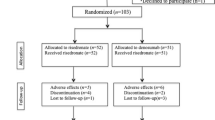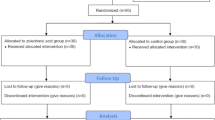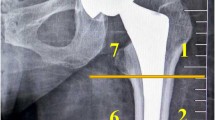Abstract
Summary
Denosumab contributed to the restoration of proximal periprosthetic bone loss around the femoral stem that were measured using a DEXA, especially in zone 7, at 1 year after cementless THA in elderly osteoporotic patients.
Introduction
Although bone quality is an important issue in elderly osteoporotic patients who underwent total hip arthroplasty (THA) with a cementless stem, periprosthetic bone mineral density (BMD) in the proximal femur has been reported to be decreased by 15–40% postoperatively. Some authors have examined the use of several types of bisphosphonates to prevent decreases in BMD in the proximal femur after cementless THA; however, few reports have demonstrated success in restoring BMD in the proximal medial femoral bone, such as zone 7.
Methods
We conducted prospective study comparing patients who underwent cementless THA administered with denosumab (10 patients) and without denosumab (10 patients). BMD around the femoral stem were measured using a DEXA immediately after surgery, and at 6 months and at 1 year after surgery. No difference was found between the two groups referred to the patient’s demographic data.
Results
We found that denosumab displayed definitive effects in increasing the % change in periprosthetic BMD at zone 7 by an average of 7.3% in patients with cementless THA, compared to control group who were given only vitamin D.
Conclusion
Denosumab is one of a number of anti-osteoporotic agents to have a definitive effect on the restoration of proximal periprosthetic bone loss, especially in zone 7, after cementless THA. Denosumab contributed to the restoration of decreased periprosthetic BMD to normal levels. As the decrease in BMD in the proximal femur after THA is considered to be apparent at 6–12 months after surgery, it is believed that prevention of the deterioration of bone quality is important in the proximal femur immediately after cementless THA for elderly female patients with osteoporosis.



Similar content being viewed by others
References
Berger RA (2003) Total hip arthroplasty using the minimally invasive two-incision approach. Clin Orthop 417:232–241
Bertin KC, Röttinger H (2004) Anterolateral mini-incision hip replacement surgery. A modified Watson-Jones approach. Clin Orthop 429:248–255
Kennon RE, Keggi JM, Wetmore RS, Zatorski LE et al (2003) Total hip arthroplasty through a minimally invasive anterior surgical approach. J Bone Joint Surg Am 85:39–48
Aro HT, Alm JJ, Moritz N et al (2012) Low BMD affects initial stability and delays stem osseointegration in cementless total hip arthroplasty in women: a 2-year RSA study of 39 patients. Acta Orthop 83:107–114
Yamada H, Yoshihara Y, Henmi O et al (2009) Cementless total hip replacement: past, present, and future. J Orthop Sci 14:228–241
Kwon DG, Lee TJ, Kang JS et al (2013) Correlation between stress shielding and clinical outcomes after total hip arthroplasty with extensively porous coated stems. J Arthroplasty 28:1728–1730
Alm JJ, Tj Makinen, Lankinen P et al (2009) Female patients with low systemic BMD are prone to bone loss in Gruen zone 7 after cementless total hip arthroplasty. Acta Orthop 80:521–537
Smolders JM, Hol A, Rijnders T et al (2010) Changes in bone mineral density in the proximal femur after hip resurfacing and uncemented total hip replacement: a prospective randomized controlled study. J Bone Joint Surg Br 92:1509–1514
Kroger H, Miettinen H, Arnala I et al (1996) Evaluation of periprosthetic bone using dual-energy X-ray absorptiometry: precision of the method and effect of operation on bone mineral density. J Bone Miner Res 11:1526–1530
Hirata Y, Inaba Y, Kobayashi N et al (2013) Comparison of mechanical stress and change in bone mineral density between two types of femoral implant using finite element analysis. J Arthroplasty 28:1731–1735
Nysted M, Benum P, Klaksvik J et al (2011) Periprosthetic bone loss after insertion of an uncemented, customized femoral stem and an uncemented anatomical stem. A randomized DXA study with 5-year follow-up. Acta Orthop 82:410–416
Spittlehouse AJ, Smith TW, Eastell R (1998) Bone loss around 2 different types of hip prostheses. J Arthroplasty 13:422–427
Knusten AR, Ebramzadeh E, Longjohn DB et al (2014) Systematic analysis of bisphosphonate intervention on periprosthetic BMD as a function of stem design. J Arthroplasty 29:1292–1297
Boonen S, Adachi JD, Man Z et al (2011) Treatment with denosumab reduces the incidence of new vertebral and hip fractures in postmenopausal women at high risk. J Clin Endocrinol Metab 96:1727–1736
Orwoll E, Teglbjaaaa CS, Langdahl BL et al (2012) A randomized, placebo-controlled study of the effects of denosumab for the treatment of men with low bone mineral density. J Clin Endocrinol Metab 97:3161–3169
Matsumoto T, Kaneuji A, Hiejima Y et al (2012) Japanese Orthopaedic Association Hip Disease Evaluation Questionnaire (JHEQ): a patient-based evaluation tool for hip-joint disease. The Subcommittee on Hip Disease Evaluation of the Clinical Outcome Committee of the Japanese Orthopaedic Association. J Orthop Sci 17:25–38
Gibbons CE, Davies AJ, Amis AA et al (2001) Periprosthetic bone mineral density changes with femoral components of differing design philosophy. Int Orthop 25:89–92
Lerch M, Kurtz A, Windhagen H et al (2012) The cementless Bicontact® stem in a prospective dual-energy X-ray absorptiometry study. Int Orthop 36:2211–2217
Pitto RP, Hayward A, Walker C et al (2010) Femoral bone density changes after total hip arthroplasty with uncemented taper-design stem: a 5 year follow-up study. Int Orthop 34:783–787
Jahnke A, Engl S, Altmeyer C et al (2014) Changes of periprosthetic bone density after a cementless short hip stem: a clinical and radiological analysis. Int Orthop 38:2045–2050
Fokter SK, Sarler T, Strahovnik A et al (2015) Results of total hip arthroplasty using a bionic hip stem. Int Orthop 39:1065–1071
Sköldenberg OG, Salemyr MO, Bodén HS et al (2011) The effect of weekly risedronate on periprosthetic bone resorption following total hip arthroplasty. A randomized, double-blind, placebo-controlled trial. J Bone Joint Surg Am 93:1857–1864
Fokter SK, Komadina R, Repše-Fokter A et al (2005) Etidronate does not suppress periprosthetic bone loss following cemented hip arthroplasty. Int Orthop 29:362–367
Scott DF, Woltz JN, Smith RR (2013) Effect of zoledronic acid on reducing femoral bone mineral density loss following total hip arthroplasty. Preliminary results of a prospective randomized trial. J Arthroplasty 28:671–675
Zabaze RM, Libanati C, Austin M et al (2014) Differing effects of denosumab and alendronate on cortical and trabecular bone. Bone 59:173–179
Faul F, Erdfelder E, Lang AG et al (2007) G*Power 3: a flexible statistical power analysis program for the social, behavioral, and biomedical sciences. Behav Res Methods 39:175–191
Author information
Authors and Affiliations
Corresponding author
Ethics declarations
Conflict of interest
Satoshi Nagoya declares that he occupies an endowed chair funded by ZimmerBiomet and Smith & Nephew. Kenji Tateda, Shunichiro Okazaki, Ima Kosukegawa, Junya Shimizu and Toshihiko Yamashita declare that they have no conflict of interest.
Rights and permissions
About this article
Cite this article
Nagoya, S., Tateda, K., Okazaki, S. et al. Restoration of proximal periprosthetic bone loss by denosumab in cementless total hip arthroplasty. Eur J Orthop Surg Traumatol 28, 1601–1607 (2018). https://doi.org/10.1007/s00590-018-2223-x
Received:
Accepted:
Published:
Issue Date:
DOI: https://doi.org/10.1007/s00590-018-2223-x




